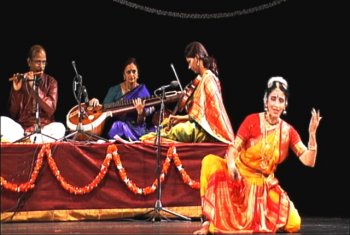 |
 |
Nandanar
Charitram in New Jersey
May 12, 2009  Gopalakrishna
Bharathi's magnum opus 'Nandanar Charitram' was presented as a unique Geetha
Nrityam presentation by Sangam Festival and Cleveland Aradhana in New Jersey
on the 25th April 2009. Bala Devi Chandrashekar danced to a highly accomplished
musical ensemble from India. The performance took the audience to an era
at Aadanoor where Nandanar lived. Rasikas were drenched in the music and
dance that merged flawlessly. Gopalakrishna
Bharathi's magnum opus 'Nandanar Charitram' was presented as a unique Geetha
Nrityam presentation by Sangam Festival and Cleveland Aradhana in New Jersey
on the 25th April 2009. Bala Devi Chandrashekar danced to a highly accomplished
musical ensemble from India. The performance took the audience to an era
at Aadanoor where Nandanar lived. Rasikas were drenched in the music and
dance that merged flawlessly.
It was Gopalakrishna Bharathi's lyrics, carefully composed music and research by veterans such as Suguna Varadhachari, supported by an excellent ensemble including Kunnakudi Balmuralikrishna, K Gayathri, Madrimangalam Swaminathan-mridangam, N Thyagarajan-flute, Ranjani Arun - violin, Jaya Sekar – veena and master Bhairav Chandrashekar – mridangam. The opera commenced with Vanakkam Kaapu, Kali Virutham, followed with an invocation to Lord Ganesha in the song Gananatha Charanam. Nandanar selling his wares was brought out in the song Varirukudhu. Bala Devi's depiction of Nandanar going about his business in the village was realistic and enjoyable. In the song Sivalokanadhanai, the earnest desire of Nandanar to go to Thirupangoor was portrayed wonderfully. The highlight of the drama was brought out in Vazhimaraikudhu, satre vilagi irum pillai. The rasikas could feel in Bala's dance, Nandanar's ecstasy on seeing the Lord at Thirupangoor; some in the audience were moved!
Madrimagalam Swaminathan's rhythmic support and Kunnakudi Balamuralikrishna's jathi rendition reinforced the overall laya harmony of the Geetha Nrityam concert. Bala’s sancharis describing the beauty and culture of the town of Thirupangoor and Chidamabram and Nandanar's awe of the temple were portrayed in a realistic manner. The nritta part of it was very well executed. The final piece depicted Nandanar becoming one with the Lord and concluded with the Thirunalaipovar mangalam based on Gopalakrishna Bharati's Nandanar Charitiram. The music was presented in various musical forms such as irusollaalankaram, dandakam, themangu, kadga, and anandakalipu. The presentation wove a clever dramatic structure that showcased carefully researched literature, music and nrityam. The extraordinary music ensemble and Bala Devi's captivating stage presence, technique and abinaya blended in perfect harmony and held the audience engrossed. |